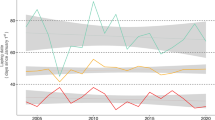Summary
In a previous paper we described a study under laboratory conditions of the pattern of development of the various categories of descendants during the life of a colony; the present study is particularly concerned with the duration of life-span of these various categories.
The life-spans of females showed a bimodal distribution and short-lived and long-lived wasps were distinguished. Considerable overlap was observed between the periods during which these two categories of wasp emerged.
A relationship was found to exist between the date of orphanship, the percentage of “short-lived” females and the sex ratio of the offspring. Colonies which lost their queen as early as June showed an increase in the number of descendants produced, but these descendants were predominantly male and, among the females, the majority were “short-lived”.
Resume
Dans un article précédent nous avons étudié au laboratoire la production des diverses catégories de descendants durant la vie de la colonie. Nous étudions ici plus particulièrement la durée de vie propre de ces diverses catégories.
La durée de vie des femelles montre une distribution bimodale et nous avons discerné des guêpes «à vie courte» et «à vie longue». Un chevauchement existe entre les phases de production de ces deux catégories.
Il existe une relation entre la date de l'orphelinage, la proportion des femelles «à vie courte» et le sex ratio de la descendance. Les colonies précocement orphelines ont, en fait, une descendance totale accrue, mais cette descendance est surtout mâle et parmi les femelles produites, les guêpes «à vie courte» sont les plus nombreuses.
Similar content being viewed by others
References
Deleurance E.P., 1957. — Contribution à l'étude biologique desPolistes (Hymen. Vesp.). I. L'activité de construction.Ann. Sci. Zool., 11e s.,19, 91–222.
Ferton Ch., 1901. — Association de Polistes pour la fondation des nids.Ann. Soc. Entom. Fr., 70, 83–148.
Greene A., 1984. — Production schedules of vespine wasps: an empirical test of the bang-bang optimization model.J. Kans. Entom. Soc., 57, 545–568.
Ito Y., Yamane S., 1985. — Early male production in a subtropical paper waspRopalidia fasciata (Hym. Vesp.).Ins Soc., 32, 401–410.
Jeanne R., 1972. — Social biology of the neotropical waspMischocyttarus drewseni.Bull. Mus. Comp. Zool., 144, 63–150.
Kasuya E., 1983. — Social behaviour of early emerging males of a Japanese waspPolistes chinensis antennalis (Hymen. Vesp.).Res. Popul. Ecol., 25, 143–149.
Khalifa A., 1953. — Biological observations onPolistes gallicus L. andPolistes foederatus Kohl with special reference to stylopization.Bull. Soc. Fouad I Entomol., 37, 371–404.
Strassmann J.E., 1981a. — Evolutionary implications of early male and satellite nest production inPolistes exclamans colony cycles.Behav. Ecol. Sociobiol., 8, 55–64.
Strassmann J.E., 1981b. — Kin selection and satellite nests inPolistes exclamans. In: Alexander R.D. Tinkle D.W. (eds).Natural selection and Social behavior: Recent research and new theory. Chiron Press, Portland, Oregon, 45–60.
Strassmann J.E., 1985. — Worker mortality and the evolution of castes in the social WaspPolistes exclamans.Ins. Soc., 32, 275–285.
Strassmann J.E., R.R. Lee, R.R. Rojas, J.G. Baust, 1984. — Caste and sex differences in cold-hardiness in the social waspsPolistes annularis andP. exclamans (Hymen. Vesp.).Ins. Soc., 31, 291–301.
Strassmann J.E., Meyer D.C., 1983. — Gerontocracy in the social wasp,Polistes exclamans.Anim. behav., 31, 431–438.
Strassmann J.E., Meyer D.C., Matlock, 1984. — Behavioral castes in the social waspPolistes exclamans (Hymenoptera: Vespidae)Sociobiology, 8, 211–224.
Suzuki T., 1981. — Effect of photoperiod on male egg production by foundresses ofPolistes chinensis antennalis Perez (Hymen. Vesp.).Jap. J. Ecol., 31, 347–351.
Suzuki T., 1982. — Cessation and resumption of laying of female producing eggs by foundresses of a polistine waspPolistes chinensis antennalis (Hymen. Vesp.) under experimental conditions.Kontyû, 50, 652–665.
Turilazzi S., Conte A., 1981. — Temperature and caste differentiation in laboratory colonies ofPolistes foederatus (Kohl) (Hymen. Vesp.)Monitore Zool. Ital. (N.S.),15, 275–277.
West M.J., 1969. — The social biology of polistine wasps.Misc. Publ. Mus. Zool. Univ. of Michigan, 140, 1–101.
Yamane S., 1972. — Life cycle and nest architecture ofPolistes wasps in the Okushiri Island, Northern Japan (Hymen. Vesp.).J. fac. Sc. Hokkaido Univ., serie 6, Zool.,18, 440–459.
Yoshikawa K., 1963. — Introductory studies on the life economy of polistine wasps. III Social stage.J. Biol. Osaka City Univ., 14, 63–66.
Author information
Authors and Affiliations
Rights and permissions
About this article
Cite this article
Gervet, J., Pratte, M., Semenoff, S. et al. Pattern of offspring production in colonies of paper wasps (Polistes gallicus L.) II. Demographic data hypotheses concerning fitness implications. Ins. Soc 33, 375–387 (1986). https://doi.org/10.1007/BF02223946
Received:
Accepted:
Issue Date:
DOI: https://doi.org/10.1007/BF02223946




